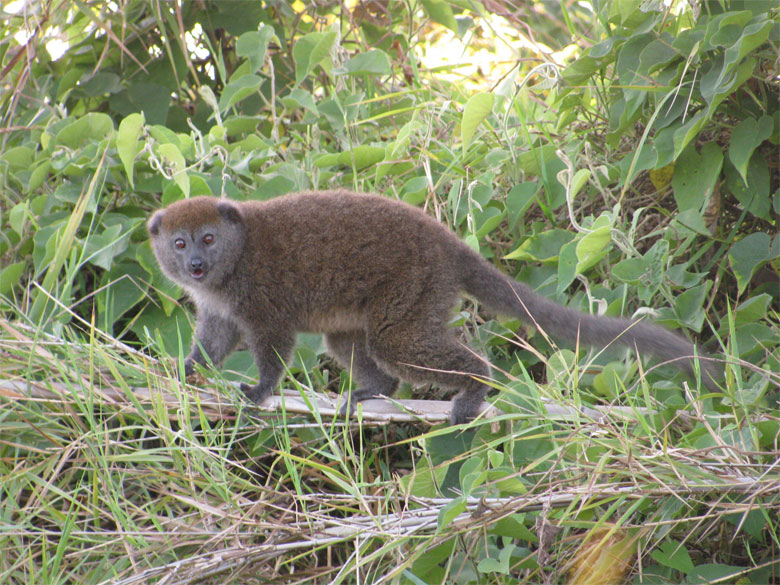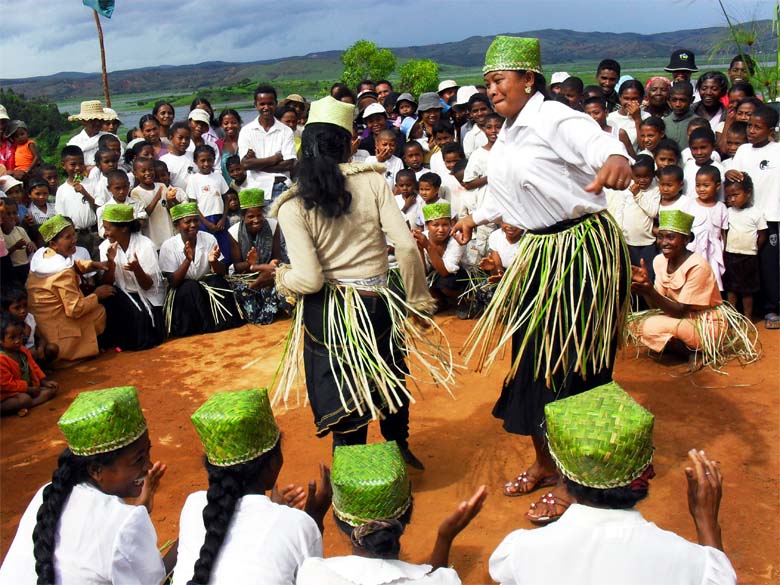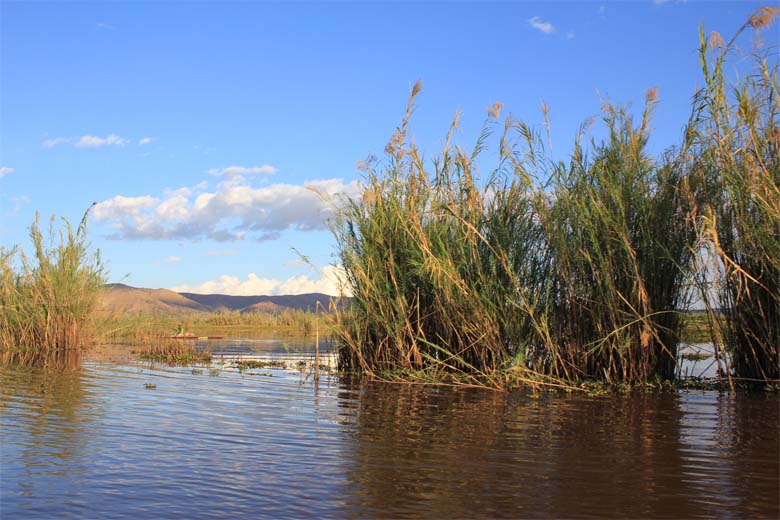- Estimates in the 1990s put the number of Alaotra gentle lemurs at just 11,000 individuals. Today that number has dropped to below 2,500. It is the only primate to live constantly on water.
- The Alaotra wetlands are richly biodiverse, with Durrell’s Vontsira, a carnivorous mongoose-like mammal unknown to science discovered in 2004 — fewer than 465 of the animals are thought to remain.
- As Alaotra’s wetland habitat has dwindled, so too have its endangered species. However, conservation groups have had considerable success with local community based protection programs, holding out hope for these species.
Climb into a canoe at dawn, paddle into the reed beds of Madagascar’s largest wetland, and with luck you could see a unique primate: the Alaotra Gentle Lemur (Hapalemur alaotrensis). Known locally as the bandro and described by Gerald Durrell as a “honey-coloured teddy bear”, these lemurs spend their entire lives within the cyperus and reed stems of the marsh around Lake Alaotra in Eastern Madagascar.
“What really fascinates me [is] that this lemur species is the only primate that lives constantly on water,” Patrick Waeber, of Madagascar Wildlife Conservation (MWC) told mongabay.com. Waeber, also a lecturer at ETH Zurich, knows the species better than most, first studying their social behavior in 2000. “It was during over 160 sampling hours that I initially came to know this compelling lemur species intimately.”
The bandro is the largest of the gentle lemurs, weighing a little over 2.5 pounds. Their dense fur grows grey on face, chest, and ears; a rich brown on head and back. A long tail helps with balance on the floating vegetation of the marsh. The animals live in small territorial family groups, and, as is typical of many lemurs, females are dominant.

People pressure driving decline
With their range extending to just 20,000 hectares (49,421 acres), their population declining, and habitat highly threatened, the species has been classified as Critically Endangered by the International Union for Conservation of Nature (IUCN). Their unique ecology and threatened status have also earned them a place on the EDGE (Evolutionarily Distinct and Globally Endangered) mammal list, a program run by the Zoological Society of London that “highlights and conserves one-of-a-kind species that are on the verge of extinction.”
“We currently estimate between 2,000 to 2,500 Bandro,” Lance Woolaver told mongabay.com. He is the head of Species Conservation and Research at the Durrell Wildlife Conservation Trust (Durrell) Madagascar. Durrell initiated some of the first studies of the bandro in the early 1990s.
“Research showed it was endangered and completely dependent on the remaining marsh,” Woolaver said. Back then, the population was estimated to be 11,000 – they have declined by almost 80 percent – and hunting for bushmeat was their greatest direct threat. In an attempt to curb hunting, Durrell reached out to the local people, holding environmental festivals to “engage local communities, discuss the importance of the marshes and demonstrate the uniqueness of the lemur to Alaotra.” This outreach was successful, with habitat loss and fragmentation – which isolates groups of bandro – now overtaking hunting as the biggest problem facing the species.
Jonah Ratsimbazafy, Secretary General of GERP (the Madagascar Primate Group) started working to conserve the bandro in 2003, and still remembers his first encounter of the bandro in the wild. “The first individual/group we saw… for me, was like discovering a diamond,” Ratsimbazafy told mongabay.com.

Ratsimbazafy also serves as the co-vice chair of the IUCN/SSC Primate Specialist Group for Madagascar, which has identified Alaotra as one of 33 priority sites for lemur conservation. He explained what drives habitat loss today: “People convert the marsh into rice field, but before doing that, they burn the marsh…. and certainly many bandro are caught in the fire.”
The marshes are burned not only to make way for rice fields, but also to improve access to fishing grounds, which are suffering from invasive plant species encroachment. “A major threat to the marsh and lake comes from an exponential increase in the number of people relying on the lake for fishing,” Woolaver said. Erosion in the lake’s headwaters is also a problem. “The lake’s long-term future depends on managing the surrounding hillsides which, due to deforestation, pour silt into the lake.”
The Alaotra wetland is at the heart of Madagascar’s “rice bowl” region, which produces a third of the national rice harvest. The lake is also a nationally important freshwater fishery. “The Alaotra was once the biggest inland fish supplier, but these stocks are now imperiled,” Waeber explained. In a country of extreme poverty these natural resources are vital in the deepest sense of the word. But exploiting them has a major impact on Alaotra’s biodiversity.
Two of the world’s rarest mammals
Alaotra’s ecological importance is not limited to the bandro. Numerous rare and endemic species inhabit the wetland, including Meller’s Duck (Endangered), and the endemic Madagascar Rainbowfish (Vulnerable). Others have already vanished, such as the Madagascar Pochard (Critically Endangered) and the Alaotra Grebe, which was declared extinct in 2010.
But even as these species struggle for survival, startling new discoveries are being made. In 2004 researchers realized that an aquatic, mongoose-like mammal observed swimming in the marshes was unknown to science. Formally described in the same year that the Alaotra Grebe’s extinction was confirmed, Durrell’s Vontsira (Salanoia durrelli) was the first new species of carnivorous mammal to be discovered in 24 years. And that’s not all. “There is also an undescribed species of mouse lemur probably unique to the marshes of Alaotra,” Woolaver said.

So far, little is known about the cat-sized Durrell’s Vontsira. It has physical adaptations to its aquatic habitat such as enlarged paws, which distinguish it from its forest-dwelling relative, the Brown-tailed Mongoose (Salanoia concolor). Knowledge of its population – estimated at fewer than 465 individuals – and its behavior is gradually accumulating thanks to weekly marsh patrols established by Durrell to monitor the bandro, the Vontsira, and illegal activities. “Camera-trapping and live-trapping have also been trialed and work well with this species,” Woolaver added.
With such low population densities, seeing either the bandro or the Vontsira in the dense marsh grasses requires a great deal of luck. What are the chances, then, of witnessing an interaction between two of the rarest mammals in the world?
“I was lucky to encounter a Salanoia [Vontsira] with one of my bandro groups back in 2000,” Waeber recalls. “The group consisted of three adults and two juveniles. The Salanoia was targeting the little ones. The adults shushed them up a cyperus to be out of reach by the carnivore. At the same time, the three adults surrounded the attacker and charged it continuously. After some minutes, annoyed by the continuous attacks, the carnivore gave up and went off.”
The global significance of Alaotra’s biodiversity was recognized in 2003, when the entire 722,500 hectare (2,790 square mile) watershed was designated a Ramsar site – recognized under the Ramsar Convention, an international wetland preservation treaty. In 2007, with the help of Durrell and other NGOs, the region was afforded further protection by the creation of a community-managed New Protected Area.
“Despite these protective designations, burning for conversion to agricultural land-use (i.e., rice production) is steadily and rapidly reducing the amount of potential lemur habitat,” Waeber said. About 6 percent of marsh habitat is lost every year.
“Marshes can recover from burning,” Waeber continued, but “because the frequency and number of fires are increasing, the chances of proper recovery of the marshes is decreasing.”
Community based management
Finding a way to balance people’s needs with the conservation of biodiversity is the key conundrum facing organizations working in the region. “Alaotra is one of Durrell’s core conservation zones in Madagascar, and the challenges there really exemplify the issues faced by conservation projects in Madagascar,” Woolaver said. “A major conservation challenge is to ensure secure livelihoods for these local communities that want to sustainably manage the lake and marshlands.”

Durrell’s early efforts to engage local communities provided the foundation for community-based management of the marshes. Durrell was instrumental in the establishment of 28 community associations which now manage 90 percent of the 23,000 hectares (56,834 acres) of marsh that remain.
A pioneering participatory ecological monitoring project was also developed, which provided communities with improved education, food security and access to clean water. “This program collected distribution data on biodiversity, and also improved relationships with local communities and encouraged them to protect the marsh,” Woolaver said.
More recently, Durrell has been providing capacity-building support for the establishment of the New Protected Area. “We want to make sure that the New Protected Area becomes a tool for sustainable management of the marsh and lake, by local communities themselves,” Woolaver explained. Durrell’s other priorities include making sure the boundaries of the protected area are clear, with “rebuilding of law enforcement and the trust between local communities and authorities” and “continuing to work with local communities to ensure good fishing management, and improved agriculture yields.”

“In order to do this we do need significant levels of engagement and long-term financial support from major development organizations and donors,” Woolaver said.

GERP, the Madagascar Primate Group, also focuses on supporting people who rely on the wetland for their livelihood. “We work with the local communities in the form of collaboration, but not dependence,” Ratsimbazafy emphasized. “We know that their involvement to the success of the project is crucial, so we provide training in farming/handcraft techniques, good governance, patrol activities, and monitoring of bandro and the habitats, for instance.”
Eco-tourism and conservation training come to Alaotra
On the eastern shore of the lake, near the town of Andreba, lies Parc Bandro, a protected area of 80 hectares (198 acres) managed by MWC. “With the consent of the community, we have built Camp Bandro to allow visitors to stay overnight, [and] to be at the lake and in the marshes by sunrise. This is the prime time for lemur watching,” Waeber explained.
A night at the Camp, followed by a dawn canoe excursion in search of the Parc’s roughly 170 bandro, will set you back just under $7. “The underpinning idea is to show the Andreba community the link between conservation… and the increased numbers of tourists.”
Unfortunately, as Waeber acknowledges, the logistical difficulties of reaching the area mean that few tourists make the journey. “Tourism in Madagascar works fine for only less than a handful of national parks which generate the majority of revenue…. [A]t Camp Bandro, we have had in the past years on average between 50 to 80 tourists.”
MWC has also been looking to the future. Training the next generation of Malagasy conservationists is a priority. Working in collaboration with both Durrell and GERP, MWC will enable 10 Malagasy students to undertake Master’s research on the bandro’s ecology and conservation.

An environmental education program aimed at primary school children and teachers has also been developed, with 3,000 comic books entitled Arovy fa harena (Protect because it’s worth it) distributed to schools so far. “The children experiencing environmental education are clearly more aware of the lake biodiversity,” Waeber said.
A cooperative solution to preservation
Increasing engagement with local communities is crucial, but they alone will not determine the fate of the Alaotra. Much of the destruction of the marsh is driven by people outside the region.
“Lack of law enforcement has led to land-grabbing by powerful people, most of whom are not even from the local communities around Alaotra,” Woolaver explained.
“That is why we try to find ways to empower the local communities,” Ratsimbazafy said. Furthermore, he thinks the law should be applied equally to all.

“In a complex socio-ecological system such as the Alaotra, conservation needs to engage with a multitude of actors,” Waeber contends. “We also need to bring our conservation efforts to the attention of the actors of change; the policy and decision makers.”
To this end, Waeber and Madagascan collaborators have launched the AlaReLa (Alaotra Resilience Landscape) project, to help resource users and decision-makers “find a balance between conservation and development, and thereby improve the adaptive capacity of Alaotra‘s social-ecological landscape.”
When it comes to the outlook for Alaotra’s people and biodiversity, there is optimism. But secure livelihoods, financial support, and political will are all needed for the region to thrive. “As long as the people depending on the marshland system are struggling to make a living, the ecosystem is at high risk to reach a point of no return,” Waeber warned. “Bridging cultural, ecological and agricultural values and needs will be key to conserving the bandro and other species such as Salanoia durrelli.”
“The two species can be saved from extinction, it isn’t too late by any means,” Woolaver concluded. “All of the knowledge, experience and techniques have been developed and are there to save the bandro and Vontsira, but a major concentrated and integrated effort requiring financial support will be required.” And if these flagship species can be saved, the rest of Alaotra’s biodiversity can be saved alongside them.

